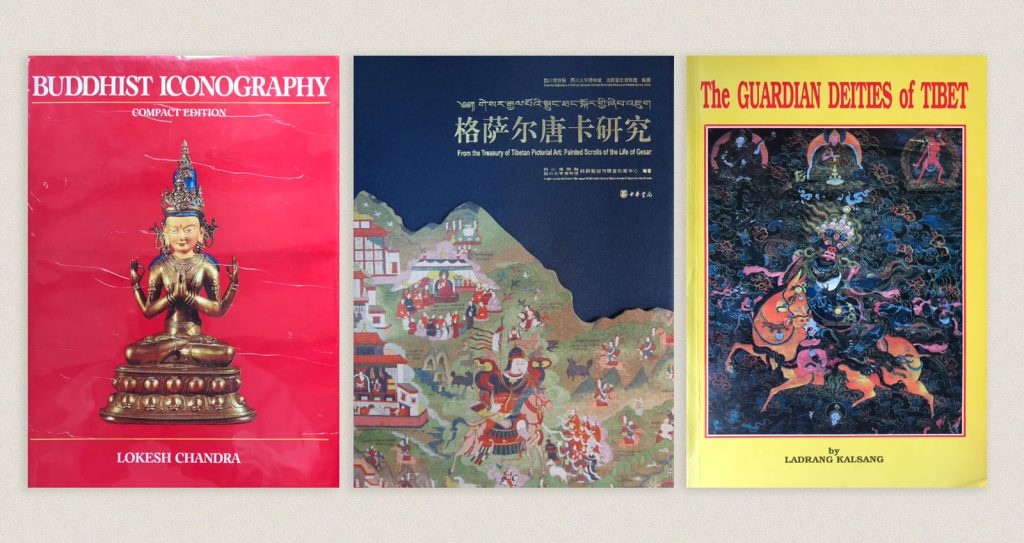Jeff Watt, director of the website and virtual museum Himalayan Art Resources (HAR) and founding curator of the Rubin Museum of Art, is better known for explaining paintings and sculptures rather than books. But in a new video series launched in October, Watt is starting to review books on art of the Himalayas and Tibet from a library that numbers in the hundreds (if not thousands). These videos may be of particular interest to students of this art, but also offer enough of an overview to engage the general public and dharma community. The video that introduces the series is below.
Watt, one of the world’s leading scholars of Himalayan art, acquired his prodigious knowledge of Buddhist, Bon, and Hindu iconography from a longtime study of Buddhism and tantra. As a teenager, he studied with Dezhung Rinpoche in Seattle, Wash., and Sakya Trizin in Dehradun, India. He dropped out of school at 17 to take monastic vows from the 16th Gyalwa Karmapa in 1974. For the next eleven years, Watt trained intensively in India, Canada, and the U.S., with teachers such as Dudjom Rinpoche, Dilgo Khyentse Rinpoche, Kalu Rinpoche, and Sakya Jetsun Chimey. In 1985 he returned to lay life but continued to study and to translate sacred Tibetan and Sanskrit texts, along with completing numerous traditional retreats over years of periodic isolated practice, much of it in the rugged mountains of British Columbia, Canada.
Watt divides the books that the new video series will review into three main categories:
- Art History
- Iconography
- Religious context
Art history books may be general or specific and describe the styles of art, the regions from which they come, the periods in which they were created, and the medium in which the artist or artists worked. Works of art history may be organized around any of these factors, or they may describe the works of specific sites or collections. They may also explain changes in artistic traditions over time.
Books discussing iconography describe the images and symbols in Himalayan art. They may explore the source literature behind pieces of art, as Watt did for the bhavacakra or wheel of existence, in a recent Tricycle article. Texts on iconography are descriptive, and detail how a figure appears in art. They also deal with the symbolic meanings in the art, and the relevant lineages of teachers related to that tradition.
The third class of books deals with religious context. These publications discuss the religious significance of works of art. They will explore the meanings of works, and how it might be employed in a ritual. They also discuss the origins of the artwork, such as what tradition it emerged from, and what it means to practitioners of that lineage. These works also deal with orthodoxy, what is deemed correct or incorrect in these works.
Watt sees the project as one of making texts accessible, as well as preserving knowledge of them. And despite HAR being a digital gallery, Watt feels that physical books are important, particularly in the Tibetan Buddhist tradition. “The importance of books,” he said, “and the importance of categorizing books, putting them in different boxes, or under different umbrellas, and organizing them: that’s one of the secrets of Tibetan Buddhism. And why it is so interesting is because of their tremendous facility and understanding of literature and books, and how to use literature.”
Digital books may provide the bare information, but there is a lack of reverence, Watt said. “You’re not protecting it, you have no responsibilities toward it,” he said. “We’ve been playing with the idea of trying to do something with books on HAR for over ten years. But trying to preserve the tradition of publications, now through video. That’s the idea.” He added, “Without doing videos and talking about some of these publications, then they may be lost forever.”
The series is new but growing. Other videos in the series deal with the art of the Bon tradition, depictions of the legendary monarch Gesar of Ling, guardian deities, oracles and demons, and much more.
Thank you for subscribing to Tricycle! As a nonprofit, we depend on readers like you to keep Buddhist teachings and practices widely available.
